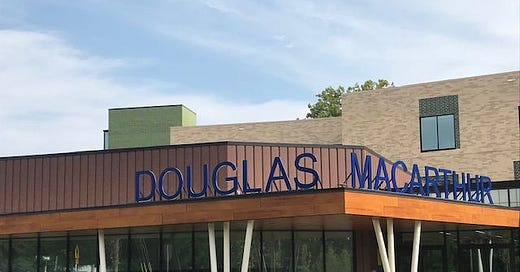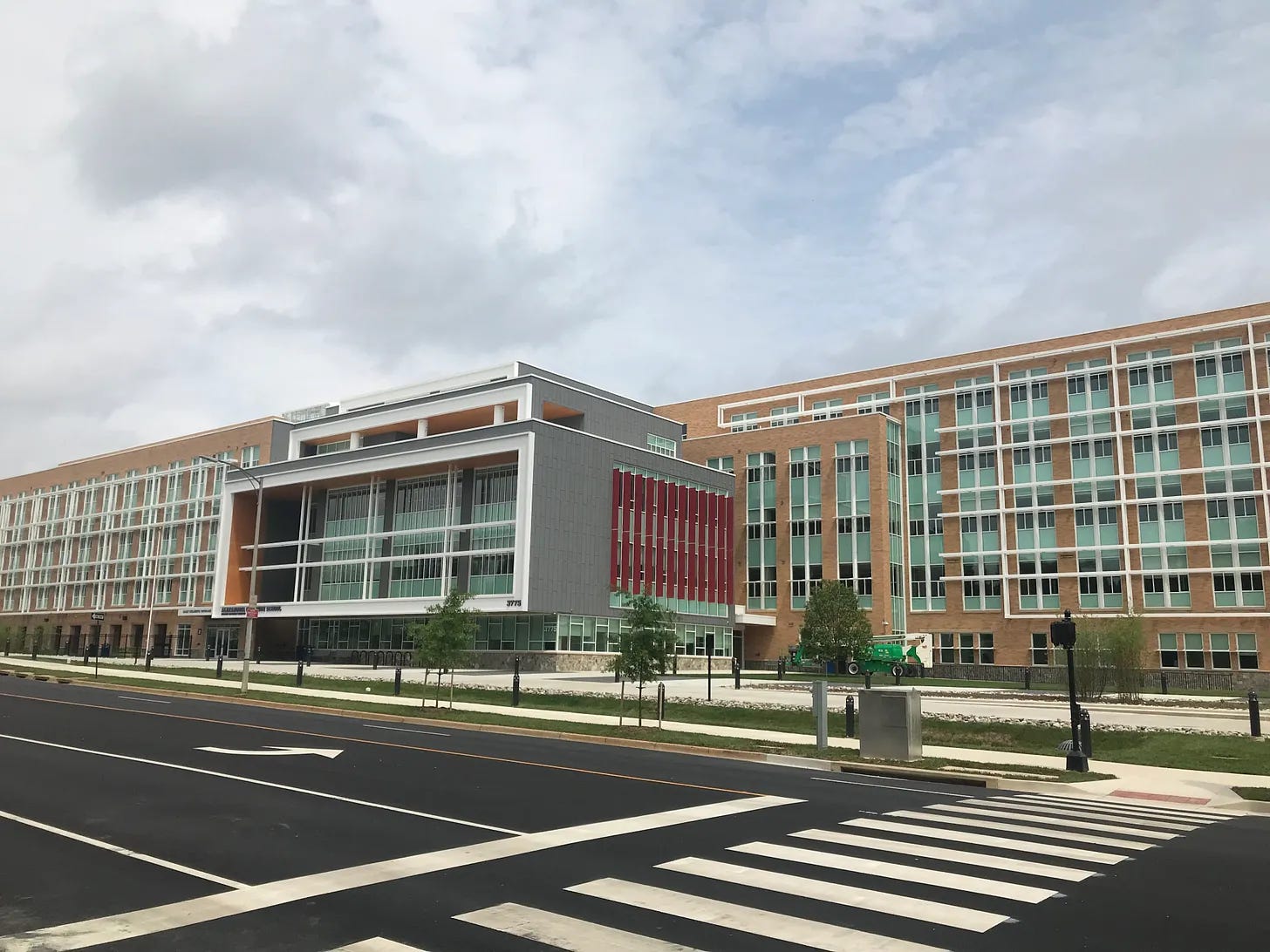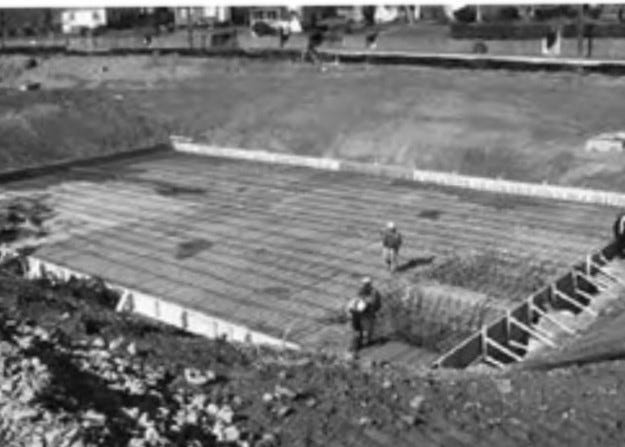Capital Projects Update: Solar Panel Interconnections and Surface Water Collection Cistern
Progress and Delays Continue for Three School Projects
Two environmentally-responsive design features, solar panels and a surface water runoff collection system, at three Alexandria City Public Schools buildings do not work for different reasons. These components may not operate for some time.
Solar Panels at Douglas MacArthur and Minnie Howard
The new Douglas MacArthur Elementary School opened in August 2023 and the new Minnie Howard Campus of Alexandria City High School opened in August 2024. Each school has solar panels designed to provide clean and renewable energy. However, the solar arrays at these schools have never been connected to the electric grid.
The time and cost to connect solar projects to the grid is a national problem. The wait time to connect new generating sources, such as solar installations, to the grid has been steadily increasing nationwide. According to a 2025 study by the Lawrence Berkeley National Laboratory, “The typical duration from connection request to commercial operation increased from <2 years for projects built in 2000-2007 to over 4 years for those built in 2018-2023 (with a median of 5 years for projects built in 2023).”
On May 27, 2024, The Washington Post reported that Virginia school systems and other public facilities were being charged substantial amounts by Dominion Energy, Inc. for the installation of fiber optic lines and a direct transfer trip, essentially a circuit breaker, to make solar panels operational. The Post reported:
Across the state, the company [Dominion] began requiring upgrades for a “direct transfer trip,” which automatically disconnects a system, on some projects. That includes laying a dark fiber optic transmission line to a substation at a cost of $150,000 to $250,000 per mile and in some cases adding a relay panel that runs $250,000 for projects exceeding 250 kilowatts, raising costs by 20 to 40 percent.
The complete Post story can be seen
On August 22, 2024, The Alexandria Times reported that ACPS faced unexpected charges of a total of $1.4 million from Dominion to connect the solar panels at Douglas MacArthur and Minnie Howard to the grid.
General Assembly Action on Solar Interconnection Costs
In the recently-concluded General Assembly session, members of the Northern Virginia delegation introduced, passed, and sent to Governor Glenn Youngkin (R) two bills addressing solar interconnection costs for public facilities statewide.
On March 24, Youngkin vetoed HB 2113, sponsored by Delegates Charniele Herring (D), Elizabeth Bennett-Parker (D) and Senator Adam Ebbin (D) that would have created a Solar Interconnection Grant Fund and Program to, according to a bill summary, award grants, “…on a competitive basis to offset costs associated with the interconnection of solar facilities to the grid.”
Ebbin also introduced SB 1058 which directed the State Corporation Commission (SCC), which regulates Dominion, to develop a cost sharing program for the connection of qualifying solar projects to the grid.
Youngkin did not veto or sign SB 1058. Instead, he proposed a substitute, HB 2266, which contained language nearly identical to SB 1058 on the solar interconnection cost sharing program.
On April 2, in the General Assembly’s one-day reconvene session, the Senate and House approved the Governor’s substitute bill which means, under Article V, Section 6 of the Virginia Constitution, that HB 2266 will become law. The history and full text of HB 2266 is viewable on the General Assembly’s Legislative Information System
HB 2266 directs the SCC to, “…establish by regulation a distribution cost sharing program” for utilities, including Dominion Energy, “to construct distribution upgrades required to interconnect triggering projects.” A “triggering project “is defined as, “a project in the interconnection queue at a given substation or feeder that requires a qualifying upgrade to successfully interconnect the project to the electric distribution system.”
HB 2266 also provides that the utilities will, “allocate costs of qualifying upgrades among any sharing projects” based on the generating capacity of each sharing project, “except that a project shall be exempted from the program if the owner or developer of such project elects to pay in full the approved cost of any associated qualifying upgrade.”
In an interview, Ebbin said that he first favored a bill that would have prohibited Dominion from charging interconnection fees for solar installations owned by public entities. Then, it became clear if that legislation was enacted, Dominion would pass these costs through to its customers as higher electric rates. Accordingly, the legislative strategy changed.
The specific cost sharing arrangements will be developed by the SCC. However, Ebbin explained that the program could involve group purchasing arrangements for the costs of connecting comparably sized projects to the grid. This would reduce what public entities would otherwise pay to connect their solar projects. The cost sharing program could also allow payments to Dominion over time for its interconnection charges.
HB 2266 directs the SCC to finalize the regulations establishing the distribution cost sharing program by July 1, 2026. The utilities, including Dominion, must file tariffs (or rates), agreements, or forms necessary to implement the program by December 1, 2026.
Ebbin said, “I’m glad we have progress on interconnection fees being shared. It’s a step forward.”
In a March 31 statement, School Board Chair Michelle Rief said:
[W]e are disappointed that the Governor vetoed Delegate Herring’s House Bill 2113. This would have provided a potential immediate solution to covering the solar connection costs at Douglas MacArthur and Minnie Howard. However, we appreciate the Governor’s support for Senator Ebbin’s Senate Bill 1058 as it encourages future solar projects across the state. We will follow the State Corporation Commission’s regulatory developments on cost sharing for public solar installation projects while also working to identify the source of the funds necessary to complete our projects.
On February 27, Dominion filed its Annual Report on Form 10-K with the Securities and Exchange Commission. The financial statements attached to the Form 10-K show that for the fiscal year ending December 31, 2024 Dominion had operating revenue of $14.4 billion and net income of $2.1 billion.
The Cistern at the ACHS King Street Campus
The ACHS King Street Campus was considered an environmentally advanced building when it opened in the fall of 2007.
The school’s design included a 450,000 square foot underground cistern, or water retention tank, under the plaza between the school and the parking deck, to collect surface water runoff to provide water for non-potable uses.
The controversy over the now-paused stream restoration project for Taylor Run, which is near the King Street Campus, increased public awareness about the desirability of capturing and reducing surface water runoff.
It is uncertain whether the cistern ever worked properly. On February 3, 2022, a column titled “Repair the ACHS Cistern” appeared in The Alexandria Times. The column can be seen
Since then, there has been halting progress in bringing the cistern online.
The cistern repairs were scheduled to be completed in the summer of 2024. On November 1, 2024, Jasmine Washington-Price of the ACPS Communications Department wrote in an email:
The ACHS cistern project is still in process. There were delays in fabrication of parts needed to complete the project. The remaining work is scheduled for completion during the ACPS winter break to accommodate a required water outage to install the necessary parts.
On February 28, 2025, Ms. Washington-Price wrote in another email:
The cistern work was not completed over winter break. As preparations were made to make repairs, additional work was identified to ensure that the cistern would properly function once new pumps are installed. The newly identified items include the installation of a new sand filter, installation of an isolation valve and a thorough cleaning of the cistern before returning it to operation. We are currently working to identify the funding necessary to complete the additional repairs required to bring the cistern back into operations.
In an April 4, 2025 statement, Dr. Alicia Hart, ACPS Chief Operating Officer, said:
The estimated cost for the cistern project is approximately $260,000. ACPS anticipates that the project will be completed by early fall 2025, barring any unforeseen circumstances that may arise during the course of the work.
Thanks for reading About Alexandria!
Subscribe for free to receive new posts.






